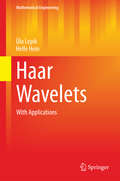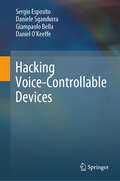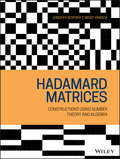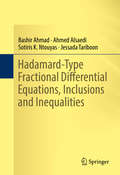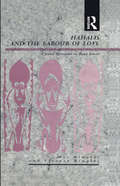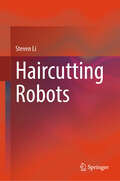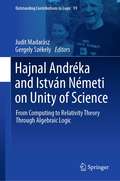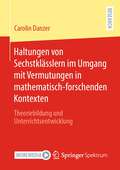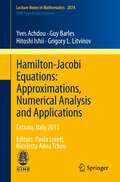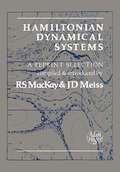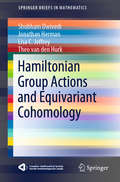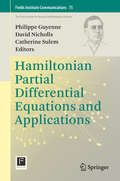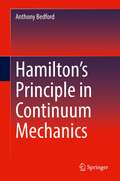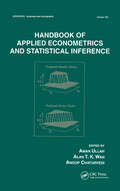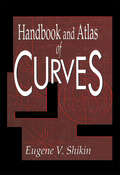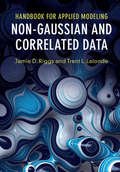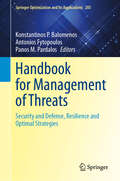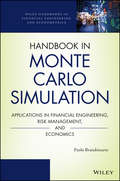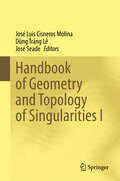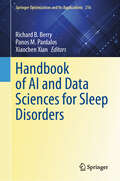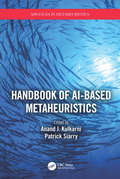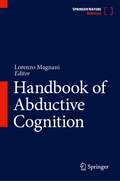- Table View
- List View
HSP Math [Grade 4]
by Joyce Mcleod Evan Maletsky Angela Andrews Minerva Cordero-Epperson Barbara Montalto Karen Norwood Janet Scheer David Wright Jennie Bennett Juli Dixon Lynda Luckie David Molina Vicki Newman Tom Roby James Mendoza EppersonNIMAC-sourced textbook
Haar Wavelets
by Ülo Lepik Helle HeinThis is the first book to present a systematic review of applications of the Haar wavelet method for solving Calculus and Structural Mechanics problems. Haar wavelet-based solutions for a wide range of problems, such as various differential and integral equations, fractional equations, optimal control theory, buckling, bending and vibrations of elastic beams are considered. Numerical examples demonstrating the efficiency and accuracy of the Haar method are provided for all solutions.
Hacking Voice-Controllable Devices
by Sergio Esposito Giampaolo Bella Daniele Sgandurra Daniel O’KeeffeVoice-controllable devices allow hands-free interactions, offering a modern user experience and helping impaired users. However, the voice channel that enables this interaction is also one of their main weaknesses. Higher usability often comes with higher security and privacy risks. As Voice-Controllable Devices are no exception to this, a plethora of new attacks have been carried out against them in recent years. In this book, several attacks are analysed against the voice channel available in the literature; it then devises a bespoke kill chain to facilitate the classification of attack steps and future research. Additionally, the work analyses the design of the notorious Alexa vs Alexa attack, which turned Echo Dot devices against themselves in 2022. Finally, the present volume explores measures against all these attacks and raise important questions about their suitability for user needs. Topics and features: Discusses timely security and privacy challenges in IoT devices, with an emphasis on voice-controllable devices Provides a framework for assessing and studying attacks against the voice channel Addresses practical attacks successfully carried out against real devices, showing that an impactful attack need not be complex Explores advanced safeguards from a new perspective, questioning whether research is proceeding in the right direction This powerful volume—containing tips, tricks, and techniques used by ethical hackers to breach the voice channel—serves as the perfect guide for researchers conducting security and privacy research on IoT. It also provides food for thought for graduate students and enthusiasts of these subjects who do not shy away from the mathematics behind the world of machine learning.
Hadamard Matrices: Constructions using Number Theory and Linear Algebra
by Jennifer Seberry Mieko YamadaUp-to-date resource on Hadamard matrices Hadamard Matrices: Constructions using Number Theory and Algebra provides students with a discussion of the basic definitions used for Hadamard Matrices as well as more advanced topics in the subject, including: Gauss sums, Jacobi sums and relative Gauss sums Cyclotomic numbers Plug-in matrices, arrays, sequences and M-structure Galois rings and Menon Hadamard differences sets Paley difference sets and Paley type partial difference sets Symmetric Hadamard matrices, skew Hadamard matrices and amicable Hadamard matrices A discussion of asymptotic existence of Hadamard matrices Maximal determinant matrices, embeddability of Hadamard matrices and growth problem for Hadamard matrices The book can be used as a textbook for graduate courses in combinatorics, or as a reference for researchers studying Hadamard matrices. Utilized in the fields of signal processing and design experiments, Hadamard matrices have been used for 150 years, and remain practical today. Hadamard Matrices combines a thorough discussion of the basic concepts underlying the subject matter with more advanced applications that will be of interest to experts in the area.
Hadamard Products of Projective Varieties (Frontiers in Mathematics)
by Cristiano Bocci Enrico CarliniThis monograph deals with the Hadamard products of algebraic varieties. A typical subject of study in Algebraic Geometry are varieties constructed from other geometrical objects. The most well-known example is constituted by the secant varieties, which are obtained through the construction of the join of two algebraic varieties, which, in turn, is based on the operation of summing two vectors. However, other constructions are possible through a change of the basic operation. One remarkable case is based on the Hadamard product of two vectors. While secant varieties of algebraic varieties have been studied extensively and systematically, the same is not yet true for the Hadamard products of algebraic varieties. This monograph aims to bridge this gap in the literature.The topic is presented in a self-contained manner, and it is accessible to all readers with sound knowledge of Commutative Algebra and Algebraic Geometry. Both experienced researchers and students can profit from this monograph, which will guide them through the subject. The foundational aspects of the Hadamard products of algebraic varieties are covered and some connections both within and outside Algebraic Geometry are presented. The theoretical and algorithmic aspects of the subject are considered to demonstrate the effectiveness of the results presented. Thus, this monograph will also be useful to researchers in other fields, such as Algebraic Statistics, since it provides several algebraic and geometric results on such products.
Hadamard-Type Fractional Differential Equations, Inclusions and Inequalities
by Bashir Ahmad Ahmed Alsaedi Sotiris K. Ntouyas Jessada TariboonThis book focuses on the recent development of fractional differential equations, integro-differential equations, and inclusions and inequalities involving the Hadamard derivative and integral. Through a comprehensive study based in part on their recent research, the authors address the issues related to initial and boundary value problems involving Hadamard type differential equations and inclusions as well as their functional counterparts. The book covers fundamental concepts of multivalued analysis and introduces a new class of mixed initial value problems involving the Hadamard derivative and Riemann-Liouville fractional integrals. In later chapters, the authors discuss nonlinear Langevin equations as well as coupled systems of Langevin equations with fractional integral conditions. Focused and thorough, this book is a useful resource for readers and researchers interested in the area of fractional calculus.
Hahalis and the Labour of Love: A Social Movement on Buka Island (Explorations In Anthropology Ser.)
by Eleanor Rimoldi Max RimoldiThis book studies the Hahalis Welfare Society, a Bougainville movement which worked for many years to maintain and reform traditional practices and to retain a degree of autonomy in a world of rapid political change and economic dependency. The first extended ethnography of Buka published in nearly sixty years, this book will be of particular interest to Melanesian specialists.
Haircutting Robots
by Steven LiThis book envisions the imminent arrival of fully robotic haircutting systems with commercial practicality, driven by advancements in technologies such as 3D printing, CNC machining, artificial intelligence, and robotics. The evolution of haircutting has reached significant milestones, from manual cutting to self-cutting devices, yet, as of 2024, no commercially available haircutting robots exist. Offering a pioneering exploration of the theoretical foundations for these innovations, the book integrates insights from robotics, AI, and aesthetic design to address challenges like precision, safety, and customization. It serves as a valuable resource for researchers, entrepreneurs, and professionals seeking to lead the development of cutting-edge haircutting solutions. With its forward-looking perspective, the book lays a roadmap for transforming personal grooming through multidisciplinary innovation.
Hajnal Andréka and István Németi on Unity of Science: From Computing to Relativity Theory Through Algebraic Logic (Outstanding Contributions to Logic #19)
by Judit Madarász Gergely SzékelyThis book features more than 20 papers that celebrate the work of Hajnal Andréka and István Németi. It illustrates an interaction between developing and applying mathematical logic. The papers offer new results as well as surveys in areas influenced by these two outstanding researchers. They also provide details on the after-life of some of their initiatives.Computer science connects the papers in the first part of the book. The second part concentrates on algebraic logic. It features a range of papers that hint at the intricate many-way connections between logic, algebra, and geometry. The third part explores novel applications of logic in relativity theory, philosophy of logic, philosophy of physics and spacetime, and methodology of science. They include such exciting subjects as time travelling in emergent spacetime. The short autobiographies of Hajnal Andréka and István Németi at the end of the book describe an adventurous journey from electric engineering and Maxwell’s equations to a complex system of computer programs for designing Hungary’s electric power system, to exploring and contributing deep results to Tarskian algebraic logic as the deepest core theory of such questions, then on to applications of the results in such exciting new areas as relativity theory in order to rejuvenate logic itself.
Haltungen von Sechstklässlern im Umgang mit Vermutungen in mathematisch-forschenden Kontexten: Theoriebildung und Unterrichtsentwicklung
by Carolin DanzerCarolin Danzer nimmt mit dieser Arbeit den Übergang von der Entwicklung einer Vermutung zur Überprüfung und Begründung oder Widerlegung dieser im Zuge mathematischer Erkenntnisprozesse von Lernenden in den Blick. Im Rahmen einer qualitativen Interviewstudie wird hierbei das Konzept der Haltung sowohl aus theoretischer als auch aus unterrichtspraktischer Perspektive ausdifferenziert. Es gelingt der Autorin, vier idealtypische Haltungen von Mathematiklernenden im Umgang mit Vermutung zu rekonstruieren, die Auswirkungen dieser auf den mathematischen Erkenntnisprozess der Lernenden zu erklären sowie Schlussfolgerungen für das Konzept einer tragfähigen Grundhaltung und die Konzeption von Mathematikunterricht zu ziehen. Damit leistet die Arbeit einen Beitrag sowohl zur mathematikdidaktischen Theoriebildung als auch zur konkreten Unterrichtsentwicklung.
Hamilton-Jacobi Equations: Paola Loreti, Nicoletta Anna Tchou
by Yves Achdou Paola Loreti Nicoletta Tchou Guy Barles Grigory L. Litvinov Hitoshi IshiiThese Lecture Notes contain the material relative to the courses given at the CIME summer school held in Cetraro, Italy from August 29 to September 3, 2011. The topic was "Hamilton-Jacobi Equations: Approximations, Numerical Analysis and Applications". The courses dealt mostly with the following subjects: first order and second order Hamilton-Jacobi-Bellman equations, properties of viscosity solutions, asymptotic behaviors, mean field games, approximation and numerical methods, idempotent analysis. The content of the courses ranged from an introduction to viscosity solutions to quite advanced topics, at the cutting edge of research in the field. We believe that they opened perspectives on new and delicate issues. These lecture notes contain four contributions by Yves Achdou (Finite Difference Methods for Mean Field Games), Guy Barles (An Introduction to the Theory of Viscosity Solutions for First-order Hamilton-Jacobi Equations and Applications), Hitoshi Ishii (A Short Introduction to Viscosity Solutions and the Large Time Behavior of Solutions of Hamilton-Jacobi Equations) and Grigory Litvinov (Idempotent/Tropical Analysis, the Hamilton-Jacobi and Bellman Equations).
Hamiltonian Dynamical Systems: A REPRINT SELECTION
by R S MacKay; J D MeissClassical mechanics is a subject that is teeming with life. However, most of the interesting results are scattered around in the specialist literature, which means that potential readers may be somewhat discouraged by the effort required to obtain them. Addressing this situation, Hamiltonian Dynamical Systems includes some of the most significant papers in Hamiltonian dynamics published during the last 60 years. The book covers bifurcation of periodic orbits, the break-up of invariant tori, chaotic behavior in hyperbolic systems, and the intricacies of real systems that contain coexisting order and chaos. It begins with an introductory survey of the subjects to help readers appreciate the underlying themes that unite an apparently diverse collection of articles. The book concludes with a selection of papers on applications, including in celestial mechanics, plasma physics, chemistry, accelerator physics, fluid mechanics, and solid state mechanics, and contains an extensive bibliography. The book provides a worthy introduction to the subject for anyone with an undergraduate background in physics or mathematics, and an indispensable reference work for researchers and graduate students interested in any aspect of classical mechanics.
Hamiltonian Group Actions and Equivariant Cohomology (SpringerBriefs in Mathematics)
by Jonathan Herman Shubham Dwivedi Lisa C. Jeffrey Theo van den HurkThis monograph could be used for a graduate course on symplectic geometry as well as for independent study.The monograph starts with an introduction of symplectic vector spaces, followed by symplectic manifolds and then Hamiltonian group actions and the Darboux theorem. After discussing moment maps and orbits of the coadjoint action, symplectic quotients are studied. The convexity theorem and toric manifolds come next and we give a comprehensive treatment of Equivariant cohomology. The monograph also contains detailed treatment of the Duistermaat-Heckman Theorem, geometric quantization, and flat connections on 2-manifolds. Finally, there is an appendix which provides background material on Lie groups. A course on differential topology is an essential prerequisite for this course. Some of the later material will be more accessible to readers who have had a basic course on algebraic topology. For some of the later chapters, it would be helpful to have some background on representation theory and complex geometry.
Hamiltonian Mechanics of Gauge Systems
by Lev V. Prokhorov Sergei V. ShabanovThis highly acclaimed series of monographs provides introductory accounts of specialized topics in mathematical physics for graduate students and research workers. The monographs in this series are of outstanding scholarship and are written by those at the very frontiers of research, Subject areas covered include cosmology, astrophysics, relativity theory, particle physics, quantum theory, nuclear physics, statistical mechanics, condensed matter physics, plasma physics, and the theory of chaos.
Hamiltonian Partial Differential Equations and Applications
by David Nicholls Philippe Guyenne Catherine SulemThis book is a unique selection of work by world-class experts exploring the latest developments in Hamiltonian partial differential equations and their applications. Topics covered within are representative of the field's wide scope, including KAM and normal form theories, perturbation and variational methods, integrable systems, stability of nonlinear solutions as well as applications to cosmology, fluid mechanics and water waves. The volume contains both surveys and original research papers and gives a concise overview of the above topics, with results ranging from mathematical modeling to rigorous analysis and numerical simulation. It will be of particular interest to graduate students as well as researchers in mathematics and physics, who wish to learn more about the powerful and elegant analytical techniques for Hamiltonian partial differential equations.
Hamilton’s Principle in Continuum Mechanics
by Anthony BedfordThis revised, updated edition provides a comprehensive and rigorous description of the application of Hamilton’s principle to continuous media. To introduce terminology and initial concepts, it begins with what is called the first problem of the calculus of variations. For both historical and pedagogical reasons, it first discusses the application of the principle to systems of particles, including conservative and non-conservative systems and systems with constraints. The foundations of mechanics of continua are introduced in the context of inner product spaces. With this basis, the application of Hamilton’s principle to the classical theories of fluid and solid mechanics are covered. Then recent developments are described, including materials with microstructure, mixtures, and continua with singular surfaces.
Handbook Of Applied Econometrics And Statistical Inference
by Aman UllahSummarizing developments and techniques in the field, this reference covers sample surveys, nonparametric analysis, hypothesis testing, time series analysis, Bayesian inference, and distribution theory for applications in statistics, economics, medicine, biology, engineering, sociology, psychology, and information technology. It supplies a geometric proof of an extended Gauss-Markov theorem, approaches for the design and implementation of sample surveys, advances in the theory of Neyman's smooth test, and methods for pre-test and biased estimation. It includes discussions ofsample size requirements for estimation in SUR models, innovative developments in nonparametric models, and more.
Handbook and Atlas of Curves
by Eugene V. ShikinThe Handbook and Atlas of Curves describes available analytic and visual properties of plane and spatial curves. Information is presented in a unique format, with one half of the book detailing investigation tools and the other devoted to the Atlas of Plane Curves. Main definitions, formulas, and facts from curve theory (plane and spatial) are discussed.
Handbook for Applied Modeling: Non-Gaussian and Correlated Data
by Jamie D. Riggs Trent L. LalondeDesigned for the applied practitioner, this book is a compact, entry-level guide to modeling and analyzing non-Gaussian and correlated data. Many practitioners work with data that fail the assumptions of the common linear regression models, necessitating more advanced modeling techniques. This Handbook presents clearly explained modeling options for such situations, along with extensive example data analyses. The book explains core models such as logistic regression, count regression, longitudinal regression, survival analysis, and structural equation modelling without relying on mathematical derivations. All data analyses are performed on real and publicly available data sets, which are revisited multiple times to show differing results using various modeling options. Common pitfalls, data issues, and interpretation of model results are also addressed. Programs in both R and SAS are made available for all results presented in the text so that readers can emulate and adapt analyses for their own data analysis needs.
Handbook for Management of Threats: Security and Defense, Resilience and Optimal Strategies (Springer Optimization and Its Applications #205)
by Panos M. Pardalos Antonios Fytopoulos Konstantinos P. BalomenosIn answer to the unprecedented challenges and threats that face today’s globalized world, the primary goal of this Handbook is to identify the most probable threats that have affected humanity in recent years and our world in years to come. The Handbook comprises mostly expository chapters that discuss tested methods/algorithms, case studies, as well as policy decision-making techniques surrounding threats and unnatural disasters, to evaluate their effects on people and to propose ways to mitigate these effects. In several chapters, new approaches and suggested policies supplement algorithms that are already in practice. The curated content brings together key experts from the academic and policy worlds to formulate a guide of principal techniques employed to gain better control over selected types of threats.This Handbook explores a wide range of technologies and theories and their impact on countering threats. These include artificial intelligence, machine learning, variational inequality theory, game theory, data envelopment analysis, and data-driven risk analysis. These tools play a vital role in decision-making processes and aid in finding optimal solutions. Additionally, a variety of optimization techniques are employed. These include (mixed) integer linear programming models for identifying critical nodes in complex systems, heuristics, approximation algorithms, and bilevel mixed integer programming for determining the most impactful links in dynamic networks. Furthermore, simulation tools are described that enable the quantification of societal resilience. These techniques collectively provide a mathematical framework capable of quantifying fundamental aspects of threats. They equip policymakers with the necessary tools and knowledge to minimize the impact of unnatural threats. The expected readership is wide and includes officials working in technical and policy roles in various ministries such as the Ministry of Defense, Civil Protection, Ministry of Public Order and Citizen Protection, United Nations, European Institutions for Threat Management, NATO, Intelligence Agencies, Centers of Excellence for Countering Threats, Think Tanks, Centers for Policy Studies, Political Leaders, the European Commission, National Institutes, International Organizations, Strategic Consulting Experts, Policymakers, and Foreign Affairs personnel. Some of these national or international organizations employ algorithms to measure resilience and enhance security. Quantification is challenging but crucial in the scenarios discussed in the book. This Handbook will also prove valuable to various universities (non-practitioners), studying systems engineering, leadership, management, strategy, foreign affairs, politics, and related disciplines.
Handbook in Monte Carlo Simulation
by Paolo BrandimarteAn accessible treatment of Monte Carlo methods, techniques, and applications in the field of finance and economicsProviding readers with an in-depth and comprehensive guide, the Handbook in Monte Carlo Simulation: Applications in Financial Engineering, Risk Management, and Economics presents a timely account of the applicationsof Monte Carlo methods in financial engineering and economics. Written by an international leading expert in thefield, the handbook illustrates the challenges confronting present-day financial practitioners and provides various applicationsof Monte Carlo techniques to answer these issues. The book is organized into five parts: introduction andmotivation; input analysis, modeling, and estimation; random variate and sample path generation; output analysisand variance reduction; and applications ranging from option pricing and risk management to optimization.The Handbook in Monte Carlo Simulation features:An introductory section for basic material on stochastic modeling and estimation aimed at readers who may need a summary or review of the essentialsCarefully crafted examples in order to spot potential pitfalls and drawbacks of each approachAn accessible treatment of advanced topics such as low-discrepancy sequences, stochastic optimization, dynamic programming, risk measures, and Markov chain Monte Carlo methodsNumerous pieces of R code used to illustrate fundamental ideas in concrete terms and encourage experimentationThe Handbook in Monte Carlo Simulation: Applications in Financial Engineering, Risk Management, and Economics is a complete reference for practitioners in the fields of finance, business, applied statistics, econometrics, and engineering, as well as a supplement for MBA and graduate-level courses on Monte Carlo methods and simulation.
Handbook of Geometry and Topology of Singularities I
by Dũng Tráng Lê José Luis Cisneros Molina José SeadeThis volume consists of ten articles which provide an in-depth and reader-friendly survey of some of the foundational aspects of singularity theory. Authored by world experts, the various contributions deal with both classical material and modern developments, covering a wide range of topics which are linked to each other in fundamental ways. Singularities are ubiquitous in mathematics and science in general. Singularity theory interacts energetically with the rest of mathematics, acting as a crucible where different types of mathematical problems interact, surprising connections are born and simple questions lead to ideas which resonate in other parts of the subject. This is the first volume in a series which aims to provide an accessible account of the state-of-the-art of the subject, its frontiers, and its interactions with other areas of research. The book is addressed to graduate students and newcomers to the theory, as well as to specialists who can use it as a guidebook.
Handbook of AI and Data Sciences for Sleep Disorders (Springer Optimization and Its Applications #216)
by Panos M. Pardalos Richard B. Berry Xiaochen XianThe rise of lifestyle changes resulting from constant connectivity, irregular work schedules, heightened stress, and disruptive sleep patterns, have contributed to increasing insomnia rates. Exacerbated by the COVID-19 pandemic, sleep disorders are more prevalent than ever. This handbook offers a comprehensive exploration of the fusion of Artificial Intelligence (AI) and data science within the realm of sleep disorders, presenting innovative approaches to diagnosis, treatment, and personalized care. The interdisciplinary nature of this handbook fosters collaboration between experts from diverse fields, including computer science, engineering, neuroscience, medicine, public health, AI, data science, and sleep medicine. Each chapter delves into specific aspects of sleep disorder analysis, innovative methodologies, novel insights, and real-world applications that showcase the transformative potential of AI and data science in sleep medicine, from analyzing sleep patterns and predicting disorder risk factors to utilizing big data analytics for large-scale epidemiological studies. This handbook hopes to offer a comprehensive resource for researchers, clinicians, and policymakers striving to address the challenges in sleep medicine.
Handbook of AI-based Metaheuristics (Advances in Metaheuristics)
by Anand J. KulkarniAt the heart of the optimization domain are mathematical modeling of the problem and the solution methodologies. The problems are becoming larger and with growing complexity. Such problems are becoming cumbersome when handled by traditional optimization methods. This has motivated researchers to resort to artificial intelligence (AI)-based, nature-inspired solution methodologies or algorithms. The Handbook of AI-based Metaheuristics provides a wide-ranging reference to the theoretical and mathematical formulations of metaheuristics, including bio-inspired, swarm-based, socio-cultural, and physics-based methods or algorithms; their testing and validation, along with detailed illustrative solutions and applications; and newly devised metaheuristic algorithms. This will be a valuable reference for researchers in industry and academia, as well as for all Master’s and PhD students working in the metaheuristics and applications domains.
Handbook of Abductive Cognition
by Lorenzo MagnaniThis Handbook offers the first comprehensive reference guide to the interdisciplinary field of abductive cognition, providing readers with extensive information on the process of reasoning to hypotheses in humans, animals, and in computational machines. It highlights the role of abduction in both theory practice: in generating and testing hypotheses and explanatory functions for various purposes and as an educational device. It merges logical, cognitive, epistemological and philosophical perspectives with more practical needs relating to the application of abduction across various disciplines and practices, such as in diagnosis, creative reasoning, scientific discovery, diagrammatic and ignorance-based cognition, and adversarial strategies. It also discusses the inferential role of models in hypothetical reasoning, abduction and creativity, including the process of development, implementation and manipulation for different scientific and technological purposes. Written by a group of internationally renowned experts in philosophy, logic, general epistemology, mathematics, cognitive, and computer science, as well as life sciences, engineering, architecture, and economics, the Handbook of Abductive Cognition offers a unique reference guide for readers approaching the process of reasoning to hypotheses from different perspectives and for various theoretical and practical purposes. Numerous diagrams, schemes and other visual representations are included to promote a better understanding of the relevant concepts and to make concepts highly accessible to an audience of scholars and students with different scientific backgrounds.

